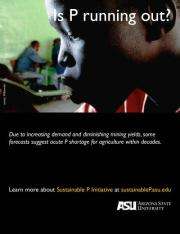Peak P? Phosphorus, food supply spurs Southwest initiative

The mineral phosphorus (P) is critical to the creation of bones, teeth and DNA. "P" is also a key component of the fertilizers used to produce our food, as critical to agriculture as water. But is P, like oil, peaking? Natural and social scientists in Europe, Australia, the United States and elsewhere see growing evidence that the answer is yes. But when? That is the question.
Predictions of P scarcity run the gamut, starting as early as 2034 to as late as 2070 or beyond. According to ecologist James Elser of Arizona State University (ASU), most people don't realize that phosphorus is mined and that these mines are a limiting resource.
"Our current use of phosphorus is not sustainable," Elser asserts.
Putting real numbers on predictions for "the biggest problem you've never heard of" has spurred the creation of the "Sustainable P Initiative" at ASU, the first focused effort in the United States to examine growing concerns about "phosphorus, food and our future."
The ASU initiative, to be unveiled on Earth Day, April 22, in partnership with the Arizona Science Center, seeks to bring people in Arizona, the Southwest, and the U.S into alignment with global efforts to find solutions with groups, such as Global Phosphorus Research Initiative, led by a consortium of Swedish and Australian scientists.
Led by Elser, a Regents' Professor in the School of Life Sciences in the College of Liberal Arts and Sciences; Mark Edwards, a professor in the W. P. Carey School of Business; and Daniel Childers, a professor in the School of Sustainability and researcher in the Global Institute of Sustainability, the ASU initiative is aimed at motivating change and advancing the design of new technologies, conservation strategies, recycling measures, and agricultural and wastewater practices to close the human P cycle.
"Globally, farmers use more than 17 million tons of mined P on their fields to produce their crops, at a cost that represents nearly 30 percent of their budget," says Edwards, an agribusiness expert.
Nearly 90 percent of the limited geological reserves of P are located in only five countries: Morocco and Western Sahara, China, South Africa, Jordan, and the United States. With only 12 mines in the U.S., and those expected to be depleted within 20-30 years, people should be concerned, says Childers. "Sustainability needs to become a priority. Many regions of world are completely dependent on imports for fertilizer. We need new ways to recycle, reclaim, and reuse what we have."
Rising energy costs complicate predictions on when mines might run out, as does limited knowledge about the reserves themselves. Donald Burt, professor of geology with ASU's School of Earth and Space Exploration, believes that peak phosphorus production might actually occur considerably earlier than 2034, if the effects of peak oil become acute before then. "Energy use impacts not just mining, but also packing, storing, transporting and applying phosphate rock and fertilizers," says Burt.
Sustainable P organizers agree: "The price of phosphate rock rose 400 percent in a recent 14 month period. Current practices are not sustainable for the long term due to decreasing geologic reserves of P, limited mines and increasing demand for this nutrient for farming due to population growth, growing affluence and bioenergy production."
Additional concerns include inefficient use and overuse of fertilizers and problems with runoff from urban and agricultural sites, which dumps P into waterways, creating ecological and economic damage, such as massive coastal "dead zones."
The scientists also cite a lack of international organizations, policies, or regulatory frameworks governing global P resources for food security.
Developing solutions will be complicated, involving all sectors of public life, points out life sciences doctoral student, Michelle McCrackin. For example, she notes in the sustainable P blog (http://sustainablep.wordpress.com/ ) that there "is an imbalance between the northern and southern hemispheres with respect to realized societal benefits of P. Significant amounts of P rock are shipped from mines in Africa to the northern hemisphere for conversion to fertilizer and application to crops. Yet, disproportionately little of this P is returned to Africa in terms of fertilizer or food. Indeed, commercial fertilizers are not affordable by many African farmers."
Launch of the Sustainable P Initiative, and subsequent events planned throughout the year, should bring clarity to such concerns, say initiative leaders. It should also advance local and regional collaborations with partners in agriculture, industry, policy, and the public to fend off dire future scenarios.
"The solutions are out there. We just need to start thinking now," Elser says. "Conservation of P is one effective strategy. In the pathway from mine, to farmer, to fork, and beyond, there is significant P waste." For example, 'waste' P in urine, feces, and agricultural runoff could potentially be transformed into a valuable source of fertilizer. A vegetarian diet would also reduce waste.
The Earth Day event in Arizona offers the public an opportunity for discussion, with an "elements and experts" mixer that puts attendees in touch with a range of subject experts in agribusiness, ecosystem ecology, bioenergy and wastewater engineering, bioengineering of food crops, agricultural ecology and biogeochemistry. Hosts include Bruce Rittmann, Regents' Professor with the Ira A. Fulton Schools of Engineering; Roberto Gaxiola, an assistant professor in the School of Life Sciences; Laura Turnbull, a research associate with the School of Sustainability; in addition to Elser, Childers, Edwards, McCrackin and others.
Provided by Arizona State University
















